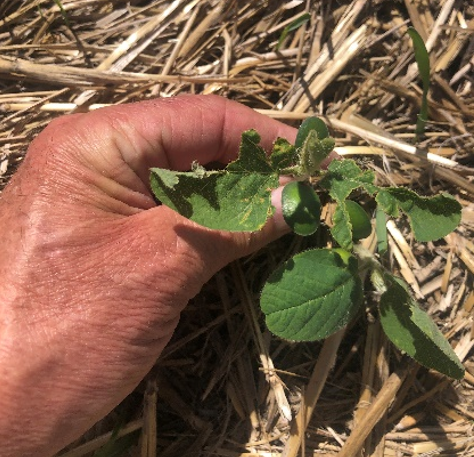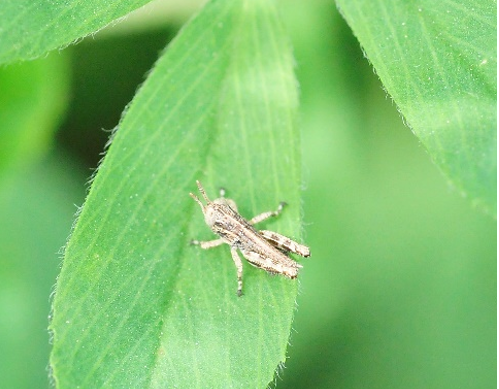Scouting for and Managing Grasshoppers
This page was adapted from the article, "Increasing Grasshoppers" (June 9, 2022) and "Grasshopper Problems Continuing" (June 23, 2022) which appeared in Crop & Pest Report.

As grasshopper nymphs (or young grasshoppers) start being observed in field edges of spring wheat and in the interior of soybean fields, it is a good time to get out and scout for grasshopper nymphs. In North Dakota, grasshopper egg hatch normally begins in early May with peak hatch occurring into mid-June. Typically, egg hatch will approach completion by late June.
There are usually 5 to 6 nymphal stages and the length of time from egg to adult is 40 to 60 days. Knowledge of grasshopper instar identification is useful because it gives a rough indication of how far the hatch has progressed. Once fourth and fifth instar grasshoppers are present, egg hatch is winding down. As nymphs mature, they become more mobile and also feed more.

Crop fields should be scouted at least once a week. Since broadleaf crop seedlings (sugarbeets, sunflowers, canola, dry beans and soybeans) are more susceptible than small grains, these crops should be inspected at least twice a week. High densities of grasshopper nymphs can cause severe foliar defoliation on emerging seedling crops in a short time.
Newly hatched grasshoppers are extremely small (about the size of a kernel of wheat) and it is difficult to count the number of nymphs per square yard when populations are high. Newly emerged grasshoppers do not usually need to be controlled unless the population is at the “threatening” level or action threshold (see Table 1). A sweep net is a good tool to collect and count small grasshopper nymphs. Pest managers can use four 180-degree sweeps with a 15-inch sweep net, which is equivalent to the number of grasshoppers per square yard.
|
|
Nymphs per square yard |
Adults per square yard |
||
|---|---|---|---|---|
|
Rating |
Margin |
Field |
Margin |
Field |
|
Light |
25-35 |
15-25 |
10-20 |
3-7 |
|
Threatening |
50-75 |
30-45 |
21-40 |
8-14 |
|
Severe |
100-150 |
60-90 |
41-80 |
15-28 |
|
Very Severe |
200+ |
120+ |
80+ |
28+ |
Grasshoppers are more easily and economically controlled while they are in the nymphal stages. A number of advantages in treating grasshoppers early include: (1) fewer acres will have to be treated and less insecticide is necessary to obtain control, thus reducing cost; (2) grasshoppers are killed before they have had the opportunity to cause significant crop loss; (3) smaller grasshoppers are more susceptible to pesticides than larger adult grasshoppers; (4) early treatment before grasshoppers reach maturity prevents egg deposition, which may help reduce the potential grasshopper threat for the following crop year.
Please see the North Dakota Field Crop Insect Management Guide for a list of insecticides registered for grasshopper control by crop.
When grasshopper nymphs reach economic levels early in the growing season, season-long control becomes challenging. There are several factors to consider when choosing which insecticide to use.
- Benzoylureas: Diflubenzuron (Dimilin 2L) is only for use west of US Highway 281, and will only control first and second instar nymphs. Dimilin 2L has about one month of residual activity, so still might be a good option to control early instars that are present or will be soon. Dimilin 2L has a 50 day pre-harvest interval, so may or may not be an option right now for winter cereals.
- For the small grasshopper nymphs (<1 inch), Dimilin® 2L, a juvenile growth regulator, is recommended for locations west of US Highway 281, for nymphs in wheat, barley, oats, triticale, alfalfa, grassland or soybean. Dimilin® 2L (active ingredient diflubenzuron, MOA Group 15) interferes with molting and controls only immature grasshoppers (not adult grasshoppers) by interfering with their normal shedding of skin (exoskeleton) as they grow. It is most effective when applied on 2nd (¾ inch long) to 4th (1-inch-long) instar grasshopper nymphs. After Dimilin® 2L has been applied, growers should notice reduced feeding in three to seven days, and maximum control in 10 to 14 days. Dimilin® 2L has low toxicity to mammals and is safer to beneficial insects than many other insecticides. Dimilin® 2L should be applied with one to two pints of an emulsified paraffinic or vegetable crop oil. Canola oil is very effective as a feeding stimulant for grasshoppers (Source: University of Wyoming).
- Organophosphates: Malathion and dimethoate are registered in several crops for grasshopper control. We’ve never tested dimethoate on grasshoppers, but we’re inclined to leave this chemistry for future spider mite problems rather than use it now on grasshoppers. Malathion is effective, but has a short residual of only a few days, and residual activity will be further reduced if applied in hot weather.
- Pyrethroids: There are several active ingredients and products. We’ve tested all pyrethroids labeled for use in soybeans, and we have had excellent control of grasshoppers using the high labeled rates. Typically, residual activity lasts for seven to ten days. However, pyrethroid applications made during hot weather (above 90⁰F) will have considerably less residual activity due to heat breaking down the active ingredient more rapidly than would occur during cooler weather. We’ve received reports in the past week of pyrethroids failing to give adequate control during the recent heat wave. Should temperatures moderate, pyrethroids would then be a good option.
- Diamides: Chlorantraniliprole (Vantacor) is effective at controlling grasshopper nymphs, and is registered for use in most of our crops. We tested Vantacor on adult grasshoppers (label indicates targeting 2nd and 3rd instar nymphs) in soybeans with excellent results. Chlorantraniliprole will not give a quick kill. However, grasshoppers stop feeding almost immediately after initial ingestion and die within a few days. Vantacor must be mixed with a high-quality MSO at 1% v/v to prevent evaporation, which is especially of concern if applied by air. If you intend to tank mix Vantacor with herbicides, be sure your herbicide(s) allows for the use of MSO. Otherwise, crop injury may result from the herbicide(s) in the presence of MSO. Vantacor works well in heat and has at least a 14 day residual, probably longer (we hope to evaluate Vantacor on nymphs this year). It’s also easier on beneficial insects compared to broad-spectrum pyrethroids and organophosphates.
Another important factor is crop growth. Currently, our spring cereals and broadleaf crops such as sunflowers and soybeans do not have much growth. Insecticide applications will protect the leaves that are present, but new growth will be unprotected. Also, insecticide that reaches the soil will not be effective, and that’s a problem now in late planted row crops. Better results can be expected as canopy closure progresses.
Lastly, avoid insecticide applications unless absolutely necessary. There are several reasons why. Repeated insecticide applications will also kill beneficial insects and mites, and may lead to flare-ups of other pests, including spider mites. We don’t want to have to deal with multiple pest issues at the same time. Pay attention to maximum seasonal use language on insecticide labels. Once you’ve reached the seasonal limit, it’s not legal to apply more of the same active ingredient to the crop for any pest. Pay attention to rotational use language - it’s best to rotate modes of action if repeated applications need to be made in order to prevent (or at least delay) insecticide resistance. Rotating modes of action also helps keep your options open for future pests this season.
For more information, see the North Dakota Field Crop Insect Management Guide.